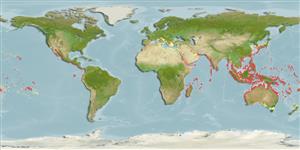Common names from other countries
Classification / Names / Names
ชื่อสามัญ | ชื่อพ้อง | Catalog of Fishes (gen., sp.) | ITIS | CoL | WoRMS
Environment: milieu / climate zone / depth range / distribution range
นิเวศวิทยา
; ระดับความลึก 0 - 25 m (Ref. 349). Tropical
Indo-Pacific and the Mediterranean.
Length at first maturity / ขนาด / น้ำหนัก / Age
Maturity: Lm ? range ? - ? cm Max length : 2.5 cm SHL เพศผู้/กระเทย; (Ref. 349); common length : 2.0 cm SHL เพศผู้/กระเทย; (Ref. 349)
Collected for food and for its shell (Ref. 349). Abundant in sheltered bays. Leaves meandering tracks at low tide on sandy shores. Occurs at the low tide mark (Ref. 349); or from immediate subtidal to 20 m in shelly sand (Ref. 337). Attacks bivalve prey through the umbo or valve center (Ref. 100855).
Life cycle and mating behavior
วัยเจริญพันธุ์ | การสืบพันธุ์ | การวางไข่ | เซลสืบพันธ์ของเพศเมีย(ไข่) | ความดกของไข่ | ตัวอ่อน
Members of the order Neotaenioglossa are mostly gonochoric and broadcast spawners. Life cycle: Embryos develop into planktonic trocophore larvae and later into juvenile veligers before becoming fully grown adults.
Poutiers, J.M. 1998. (Ref. 349)
IUCN Red List Status (Ref. 130435)
CITES status (Ref. 108899)
Not Evaluated
Not Evaluated
Human uses
| FishSource |
เครื่องมือ
ข้อมูลเพิ่มเติม
Age/SizeการเจริญเติบโตLength-weightLength-lengthสัณฐานวิทยาตัวอ่อนอุดมสมบรูณ์
แหล่งที่มาจากอินเตอร์เน็ต
Estimates based on models
Preferred temperature
(Ref.
115969): 22.9 - 29.2, mean 28.3 (based on 3791 cells).
Vulnerability
Low vulnerability (10 of 100).
Price category
Unknown.
